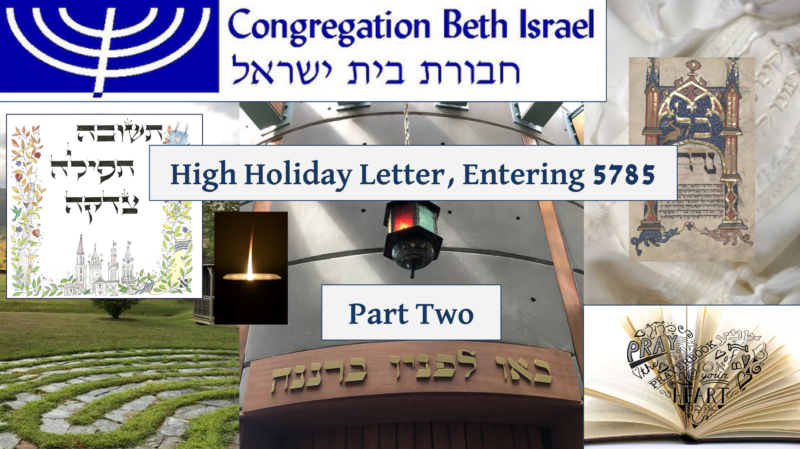Dear Congregation Beth Israel members and friends,
As these words go out to you, we’re in the midst of the Ten Days of Teshuvah between Rosh Hashanah and Yom Kippur. According to tradition, our hearts and souls are particularly elastic and malleable at this time of year. We haven’t yet settled into the patterns of the new Jewish year. Whatever groundwork we lay now can set the spiritual tone for what our new year might become.
This is part two of this year’s high holiday letter; the first part went out before Rosh Hashanah.
Notes About Yom Kippur
I love Yom Kippur. I know that probably sounds weird to most folks, but it’s true. I love it because the day feels meaningful from start to finish. It’s a whole day of introspection and togetherness and song, and these are a few of my favorite things. I love the solemn grandeur of Kol Nidre. I love the feeling of walking our meditation labyrinth in the changing light during minhah (afternoon prayer). And I love singing in front of the open ark while the twilight grows at the end of Ne’ilah, the service that brings the day to its close.
Here’s a post from a few years ago that explains some of the customs of Yom Kippur, including wearing white, why some of us avoid leather, and the unusual practice of donning a tallit at night. (Note that there’s one thing in that old post that’s out of date – we won’t begin with 30 minutes of classical music before Kol Nidre services this year. We will begin with one piece of classical music just before services formally begin – the Max Bruch setting of Kol Nidre – so arrive a few minutes early for Kol Nidre in order not to miss that at the very start.)
Kol Nidre and Yom Kippur morning services this year will both feature lots of music, and (CBI member and cantorial soloist) Ziva Larson and I added more music to this year’s Yizkor / memorial service at the end of Yom Kippur morning. At Yizkor we’re also planning to recognize those we’ve lost in a global sense this year before transitioning to remembering those who have died in our own families and community. There will be an opportunity to grieve the world’s losses before we shift gears to look inward at our own circles of care.
On Yom Kippur afternoon at 3pm I’ll hold the final class in our Repentance & Repair / Journey of Teshuvah class. This class is designed to be accessible for and meaningful to those who took the seven-week Tuesday evening journey with me and Rabbi David this summer, and to those who didn’t! So even if you didn’t take that class, you are most welcome and encouraged to join this final session on teshuvah, forgiveness, and what Yom Kippur is for. I promise that the learning will be deep and meaningful.
 From there we’ll move into afternoon services, including a new multimedia experience for the Avodah service (recalling the practices of the high priest long ago) and a new Book of Jonah script alongside beautiful new high holiday art.
From there we’ll move into afternoon services, including a new multimedia experience for the Avodah service (recalling the practices of the high priest long ago) and a new Book of Jonah script alongside beautiful new high holiday art.
At Ne’ilah (the closing service of Yom Kippur) we’ll turn off most of the lights in the sanctuary so we can viscerally feel the changing light around us as the day draws toward its end. As always, there will be time during that service to approach the open ark and whisper our deepest prayers there while we sing holiday music without words.
Hopefully you’ve already signed up for the Break-the-Fast after Yom Kippur. Don’t forget also to sign up for our Harvest Moon Shabbat Sukkot potluck and bonfire singalong, Sukkot Shabbat morning services led by R. Pam Wax, and Simchat Torah Celebration & Dance Party with live band and dancing with our Torah scrolls! Seeking joy in the Torah, in our stories, in our rituals, and in our community feels more important than ever as we begin this new Jewish year. Maybe that’s always true, but it feels extra-true for me after the difficult year that just ended.
The last thing I want to say is: be as you need during the holidays. If your body needs to stretch or move, get up and honor that need. If your heart needs quiet introversion, you can go under a tallit (as some of us do during Yizkor) or walk the meditation labyrinth. “If you want to sing out, sing out,” in the words of the former Cat Stevens – and if you don’t know the words, “yai dai dai” is always appropriate!
The Days of Awe are a spiritual marathon, and we all find that our energy ebbs and flows. Sometimes we’ll be focused, even riveted, and other times our attention might wander. All of this can move us, inspire us, change us. All of this can serve the higher purpose of helping us become the people we’re most called to be.
I look forward to being with you on Yom Kippur – and during Sukkot – and throughout the year to come.
Blessings to all,
— Rabbi Rachel






